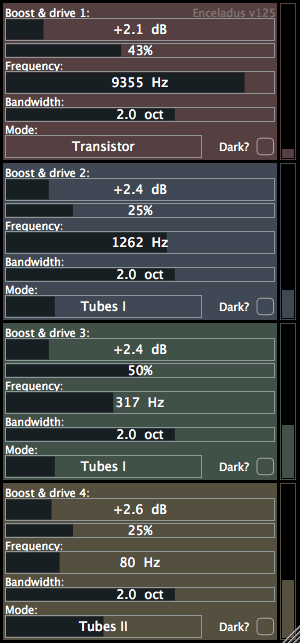|
|
Audio Plugins
|
Enceladus EQ
 This is an equalizer that tries to simulate the rich phat sound of analog equalizers.
It can only boost, which may seem like a strange limitation, but it's a result of the way the algorithm works.
The "drive" feature only works for bands that are boosted.
Some day I might change the graphics.
This is an equalizer that tries to simulate the rich phat sound of analog equalizers.
It can only boost, which may seem like a strange limitation, but it's a result of the way the algorithm works.
The "drive" feature only works for bands that are boosted.
Some day I might change the graphics.
How To Use It
Each band has "boost", "drive", "frequency", "bandwidth" and "mode".
Boost - amplifies the sound at the chosen frequency.
Drive - adds soft saturation to the boosted frequency area. This only works if "boost" is more than 0.
Frequency - select which frequency the band works at.
Bandwidth - select how wide the affected area is.
Mode - switches between the three different saturation modes (recommended), as well as two experimental features that behave more or less like a dynamic EQ, boosting only if there isn't too much at the chosen frequency range already - a bit like a dynamic EQ.
Dark - further softens the applied saturation, but can also introduce slight phase trouble, so use with caution.
Download
Tips & facts
- Apple install guide
- The meters on the right side show how much you're effectively boosting.
- The amount of dB boosted may be more than indicated when "Drive" is more than 0%
- The amount of harmonic distortion / saturation is a product of both boost and drive.
- It's easier to tell the difference betweewn the different modes and the "dark" mode if you use so much "Drive" that the red overload indicator starts flashing a little bit.
- If you have trouble making the meters reach levels as loud as this screenshot, try sending a louder signal into the plugin.
Version history
- v183: Enabled oversampling when running in 48 kHz and lower to avoid deformations of the EQ curve in the treble.
- v167: Modernizations of the internal code structure.
- v125: May possibly have fixed a bug reported by one user (unverified).
- v64: Window width can now be scaled in some hosts. Slight improvement of an internal filter used for the "dark" mode.
- v55: Added overload indicator. Raised "Tubes I" level a slight bit to match the other two algorithms. Fixed bug where compressor would always boost wildly.
- v53: Lowered minimum signal threshold for when EQ algorithm gets enabled, and made steps smaller for boost and frequency.
- v52: Signals had to be appx. 20 dB louder than typical use-cases for the Drive parameter to work properly. This is now fixed.
- v50: Changed the way the version number is displayed. Versions 49 and 50 are identical.
- v49: First beta that seems to work.
Website by Joachim Michaelis
|
|
|
|
 This is an equalizer that tries to simulate the rich phat sound of analog equalizers.
It can only boost, which may seem like a strange limitation, but it's a result of the way the algorithm works.
The "drive" feature only works for bands that are boosted.
Some day I might change the graphics.
This is an equalizer that tries to simulate the rich phat sound of analog equalizers.
It can only boost, which may seem like a strange limitation, but it's a result of the way the algorithm works.
The "drive" feature only works for bands that are boosted.
Some day I might change the graphics.